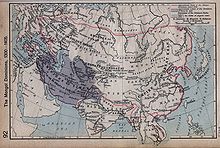The Mongol Empire and the states that emerged from it played a major role in the history of the 13th and 14th centuries. Genghis Khan and his immediate successors conquered nearly all of Asia and European Russia and sent armies as far as central Europe and Southeast Asia.
Genghis Khan abolished the organization of the former tribes and confederations and reformed the country into 95 mingats. In this system, a group of households large enough to mobilize ten warriors was organized into an arbatu, 10 arbatus were organized into a zagutu (100 warriors), 10 zagutus constituted a mingat (1,000 warriors) and 10 mingats constituted a tumetu or tumen (10,000 warriors). This decimal system was a long-tested system that had been inherited from the period of the Xiongnu. With an assumption that each household consisted of four persons and every adult male was a warrior, it can be estimated that the entire population of Mongolia was at least 750,000 people and the nation possessed 95,000 cavalrymen.
The newly unified Great Mongol State became an attractive force for many neighbouring peoples and kingdoms. Beginning from 1207, the Uighur state, Taiga people of the river Yenisey and the Karluk kingdom joined Mongolia. The urgent task of Genghis Khan was strengthening the independence of his young nation. For a century, the southeastern neighbour Jin dynasty had been provoking the Mongolic tribes against one another in order to eventually subjugate them. With a purpose of testing the military strength of his state and preparing for a struggle against the Jin dynasty, Genghis Khan conquered the Tangut empire Xi-Xia, which pledged vassalage.
In the year, Mongolia, with over 90,000 cavalrymen, started a war with the Jin dynasty which had a multi-million population. At this stage, the Mongols passed over the Great Wall, invaded Shanxi and Shandong provinces, and approached the river Yellow River. The "Altan (Golden) Khaan" (Jin Emperor) surrendered in 1214 and gave Genghis Khan his princess and tribute of gold and silver to his warlords. Genghis Khan gave out to his warriors the tribute of the Jin Emperor loaded on 3000 horses. However, the Jin dynasty continued hostility against Mongolia, hence Genghis Khan ordered his warlord Guo Wang Mukhulai of the Jalair clan to complete the conquest of the Jin dynasty and returned to Mongolia.
Later, the warlord Jebe of Besud clan defeated Kuchulug who had become the Gur-Khan of Qara Khitai. His power was weak as he, a Buddhist, persecuted the indigenous Muslim population.
Genghis Khan intended to develop friendly relations with the Khwarezm Empire, which was on a junction of the trade routes connecting the East and the West and dominated Central Asia, Iran and Afghanistan. Genghis Khan considered himself a supreme ruler of the East and Khwarezm Shah a supreme ruler of the West. Khwarezm Shah had an opposite view that there should be only one ruler on earth as there is only one sun in the sky.
The execution of 450 envoys and tradesmen of Genghis Khan by Khwarezm Shah 1218 was an announcement of war. The Mongol troops invaded Khwarezm Empire in 1219. Although Khwarezm Shah possessed an army outnumbering the Mongol troops dozen of times, he lacked the courage and initiatives to unite his forces and fight back.[citation needed] The Mongol troops sacked cities Otrar, Buhara, Merv and Samarkand. Shah's warlord Temur-Melik led a daring resistance when the Mongol troops besieged city of Khujand. Shah's son Jalal ad-Din Mingburnu courageously battled with the Mongol army in 1221, but was defeated and escaped to the river Ind.
Pursuing Khwarezm Shah in 1220, the scout groups of warlords Jebe and Subedei bagathur of Uriankhai clan conquered northern Iran. They invaded Iraq, Azerbaijan, Armenia and Georgia in 1221 and entered the territories of the Kipchak Khanate in Crimea and grasslands of the northern Black Sea. The Kipchaks allied with the troops of the principalities of Rus gave battle to the 30,000 cavalrymen of Jebe and Subedei on the river Kalka in May 1223, but were defeated and were chased up to the river Dnieper.
The Tangut kingdom denied its obligation as a vassal state to take part in the western campaign of Genghis Khan. Shortly after returning to Mongolia, the Mongol army invaded the Tangut state in 1226 and conquered the capital Zhongxing (中兴府), located in modern Yinchuan. The Tangut kingdom completely surrendered in March 1227.
Mongolic Khitans and Tuyuhuns or Monguor people (1227) came under rule of the Mongol Empire after conquest of the Tanghut's Western Xia and Tungusic Jin Empires. The Qara Khitai was conquered by the Mongols under Genghis Khan in 1218.


No comments:
Post a Comment